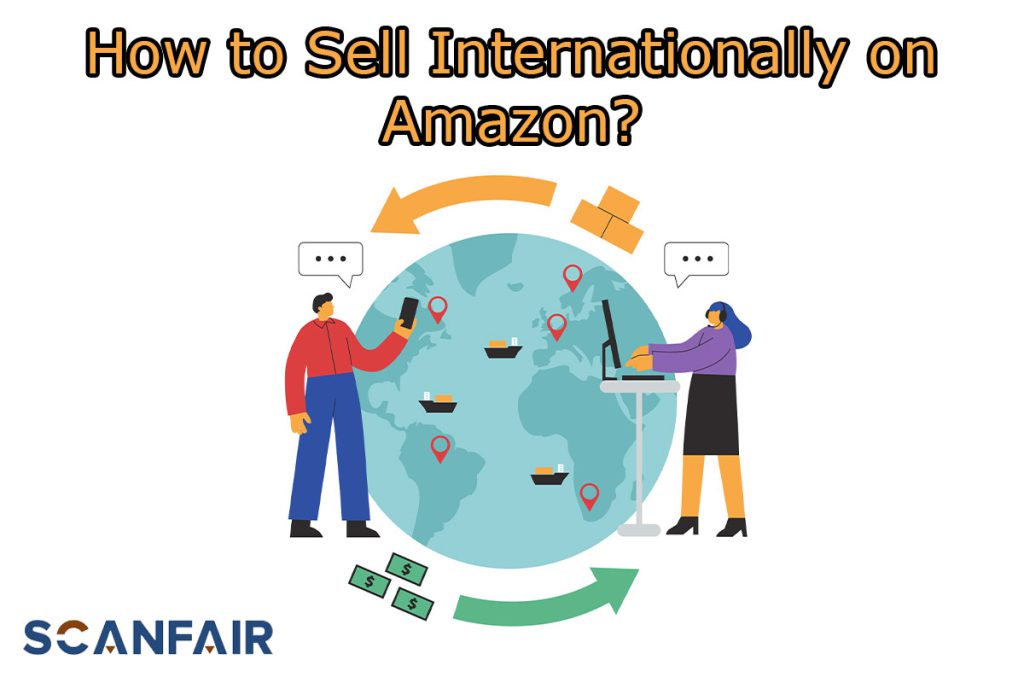In today’s interconnected world, the realm of e-commerce transcends borders, presenting a golden opportunity for businesses to tap into global markets and offer their products and services to a vast and diverse audience. At the forefront of this global marketplace stands Amazon , celebrated as the world’s largest online platform. For entrepreneurs and businesses alike, Amazon serves as the gateway to venture into the lucrative realm of international sales. In this extensive guide, we will delve deep into the intricacies and strategies that will empower you to successfully navigate the complexities of selling your products on Amazon’s expansive array of international marketplaces. The purpose of this article is Scan fair How to Sell Internationally on Amazon?
International Selling on Amazon
Before we dive into the specifics of international sales on Amazon, it’s crucial to understand why it holds immense value for your business:
Global Customer Base
Amazon boasts an astounding 500 million customers worldwide. Embracing international sales provides you with access to this expansive and diverse market, unrivaled by any single national marketplace. It’s a world of consumers waiting to explore what your business has to offer.
Expanding your customer base: When you embrace international selling on Amazon, you are essentially unlocking a global customer base that transcends geographical boundaries. This vast audience is diverse, with varying preferences and needs, offering immense potential for growth.
Revenue Growth
Expanding into international markets has the potential to significantly amplify your revenue streams. It diversifies your sources of income, reducing dependency on a single market and enhancing financial stability. In essence, it’s an investment in the long-term financial health of your business.
Diversifying your income: Relying solely on one market can be risky. Economic downturns or shifts in consumer behavior can impact your revenue. International selling spreads your risk and ensures you have multiple income streams, contributing to financial stability and growth.
Competitive Edge
Selling internationally provides you with a competitive advantage over competitors who limit themselves to local markets. It positions your business favorably in the global arena, opening up new avenues for growth and ensuring you stay ahead of the curve in an ever-evolving marketplace.
Staying ahead of competitors: In today’s fast-paced business landscape, staying stagnant is not an option. International selling allows you to outpace competitors who are confined to local markets and potentially gain a first-mover advantage in new markets.
Brand Exposure
Global expansion enhances your brand’s visibility and reputation on a global scale. It solidifies your presence in the e-commerce landscape and establishes your business as a reputable global player. Your brand becomes a trusted name across borders.
Building a global brand: Becoming a recognized brand in international markets is a powerful asset. It not only increases your credibility but also fosters trust among international customers who may be unfamiliar with your business. A strong global brand can lead to brand loyalty and repeat business.
Registering for Amazon Global Selling
Embarking on your international selling expedition via Amazon begins with the crucial step of setting up your Amazon Global Selling account. If you haven’t taken this leap yet, follow these comprehensive steps:
a. Creating Your Amazon Seller Account
- Sign Up for a Seller Account: Commence your journey by visiting Amazon Seller Central and initiating the sign-up process for your seller account. It’s the first step towards unlocking a world of opportunities.
- Select Your Target Marketplace (5): Amazon offers a multitude of marketplaces, each catering to specific regions or countries. Choose the marketplace(s) that align with your international selling aspirations. Your choice will define your reach.
Strategic marketplace selection: Your choice of target marketplace is a strategic decision that requires careful consideration. Factors such as market size, competition, and regulatory requirements should influence your decision. Different marketplaces offer distinct opportunities, and a well-thought-out selection can significantly impact your success.
b. Legal and Financial Considerations
Selling internationally introduces a realm of legal and financial intricacies. Ensure you are well-prepared in these aspects:
Business Registration: Register your business and ensure compliance with the regulations of both your home country and the target countries where you intend to sell. Legal groundwork is essential for a stable international venture.
Navigating legal complexities: International business often involves compliance with various legal requirements, including business registration, licensing, and intellectual property protection. It’s essential to seek legal guidance to ensure your business operates within the bounds of the law.
Tax Information: Methodically set up your tax information, encompassing tax identification numbers and VAT (Value Added Tax) registration if applicable. Taxes are an unavoidable part of global business, and understanding them is key.
Mastering international taxation: International taxation can be complex due to varying tax laws and regulations in different countries. Collaborating with tax experts who specialize in international tax can help you optimize your tax strategy while remaining compliant.
Bank Account: Secure a local bank account in your target country to facilitate seamless payment reception and disbursement. Efficient financial transactions are the lifeblood of international sales.
Streamlining international transactions: International business transactions often involve multiple currencies and complex payment processes. Setting up local bank accounts can reduce currency exchange fees and streamline financial operations.
Amazon Policies
Before listing your products on international marketplaces, it is imperative to have a comprehensive understanding of Amazon’s policies and product eligibility criteria. Certain products may be subject to restrictions or necessitate additional documentation. Familiarize yourself with Amazon’s stringent guidelines to avoid potential hurdles and ensure compliance.
Adhering to Amazon’s policies: Amazon has specific rules and regulations governing product listings, product quality, and seller conduct. Violating these policies can result in penalties or suspension of your selling privileges. It’s crucial to stay informed and comply with Amazon’s guidelines to maintain a strong presence on the platform.
Product Listings for International Markets
Crafting International Listings
Creating international listings represents a pivotal step in your global Amazon journey. Each marketplace may have distinct prerequisites for product titles, descriptions, and images. Here’s your roadmap:
Localized Content : Tailor your product listings to resonate with the local language and culture of your target market. Ensure that titles, descriptions, and other content are thoughtfully translated. Your products should feel at home in their new market.
Effective localization: Localization goes beyond translation; it involves adapting your product listings to the cultural norms, preferences, and nuances of the target market. It’s a strategic move that enhances the appeal of your products to local customers.
Currency and Pricing : To facilitate international customers in comprehending your product’s value, set prices in the local currency. This assists them in gauging the cost more effectively. Pricing should be clear and competitive.
Dynamic pricing strategy: International pricing requires a dynamic approach. Consider factors like currency exchange rates, local competition, and cost structures. Implementing an effective pricing strategy can give you a competitive edge in international markets.
b. Shipping and Fulfillment
Shipping and fulfillment methods may exhibit variations across different marketplaces. Amazon provides a spectrum of options:
Fulfillment by Amazon (FBA): Leverage Amazon’s comprehensive fulfillment services, entrusting them to store, package, and dispatch your products efficiently. This guarantees reliable and prompt delivery to your international customer base. FBA is your key to seamless logistics.
Efficient fulfillment: FBA simplifies international logistics by handling storage, packaging, and shipping on your behalf. It ensures consistent and reliable order fulfillment, enhancing the customer experience and your seller performance.
Third-party Logistics (3PL) : Alternatively, you retain the flexibility to opt for third-party logistics providers to handle your international shipments. Choose a partner that aligns with your global strategy.
Tailored logistics solutions: Partnering with a 3PL provider allows you to customize your logistics strategy to meet the specific needs of your international business. It can be a cost-effective and flexible solution, especially if you have unique shipping requirements.
Managing Orders and Customer Service
Selling internationally entails adeptly managing orders and providing impeccable customer support to clients spanning the globe. Be well-prepared to execute the following:
Multilingual Customer Communication: Offer customer support in multiple languages to cater to the diverse needs of international customers effectively. Effective communication transcends language barriers.
Language proficiency: Multilingual customer support is not just a courtesy; it’s a necessity in international selling. It ensures that customers can communicate with your business comfortably, leading to higher customer satisfaction and trust.
Seamless Shipping and Tracking: Keep a vigilant eye on international shipments, furnishing customers with precise shipping information for a seamless experience. Transparency and reliability are the cornerstones of international shipping.
Real-time tracking: International customers expect transparency when it comes to their orders. Providing real-time tracking information helps them stay informed about their shipments, reducing anxiety and inquiries.
Returns and Refunds: Establish clear and transparent policies for international returns and refunds, cultivating trust and customer satisfaction. Fair and efficient returns are crucial for customer loyalty.
Customer-centric returns: International customers should have a straightforward process for returns and refunds. Clear policies and efficient handling of returns contribute to a positive buying experience and build trust with customers.
Crafting Pricing Strategies for International Success
Pricing plays a pivotal role in determining your success in international markets. Consider factors such as currency exchange rates, local competition dynamics, and shipping costs when crafting your pricing strategies for optimal results. Your pricing should reflect the value you offer in each market.
Dynamic pricing optimization: International pricing is not one-size-fits-all. Implement dynamic pricing strategies that account for currency fluctuations, local demand, and competitor pricing. Continuously monitor and adjust your prices to remain competitive and maximize profitability.
Venturing into Additional International Markets
Once you’ve fortified your presence in one international marketplace, contemplate expanding into others. Each marketplace presents its unique opportunities and challenges. Meticulously research and strategize your expansion efforts accordingly. It’s a journey of growth and diversification.
Strategic expansion: Expanding into additional international markets requires careful planning and research. Consider factors like market size, consumer behavior, and competition. Tailor your product offerings and strategies to meet the unique demands of each market.
Deciphering Amazon Global Selling Fees
A comprehensive understanding of the fees associated with international selling is indispensable for effective profitability management. These fees may encompass shipping charges, referral fees, and currency conversion costs. Familiarize yourself with Amazon’s fee structure governing international sales. Be financially savvy in the global marketplace.
Cost management: Efficiently managing your costs is crucial for international success. Understand the various fees associated with international selling and factor them into your pricing strategy. Monitor your expenses and look for opportunities to optimize costs while maintaining quality.
Tailoring Global Selling Strategy
Continual optimization of your international selling strategy is a hallmark of enduring success. Monitor performance metrics, heed customer feedback, and stay attuned to market trends. Adapt your approach to cater to the unique demands of each international marketplace. The global market is dynamic, and your strategy should evolve with it.
Data-driven decision-making: Leverage data and analytics to drive your international selling strategy. Regularly review performance metrics, customer feedback, and market trends. Use this information to make informed decisions and continuously improve your approach.
Conquering Challenges and Thriving Globally
Selling internationally on Amazon introduces its fair share of challenges, ranging from language barriers and currency fluctuations to varying consumer preferences. Forge ahead with adaptability and resilience, finding innovative solutions to these challenges as your international business continues to flourish. Challenges are opportunities in disguise.
Adaptability and innovation: Embrace challenges as opportunities to innovate and grow. International business will present unforeseen obstacles, but your ability to adapt and find creative solutions can set you apart from competitors and drive long-term success.
Conclusion
Selling internationally on Amazon unfurls a realm of opportunities for e-commerce visionaries. By diligently following these well-defined steps and embracing adaptable strategies, you can seamlessly navigate the intricacies of international markets. Patience, resilience, and a commitment to understanding local nuances are the linchpins of your international selling triumph on Amazon. Venture forth into this global odyssey, and witness your business not only expand but thrive on a worldwide scale.As we conclude this comprehensive guide, remember that international selling on Amazon is not just a business expansion; it’s a journey of global discovery and growth. Embrace it with open arms, and your business will thrive on the global stage.




